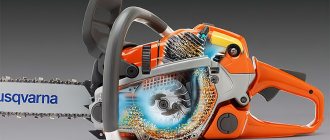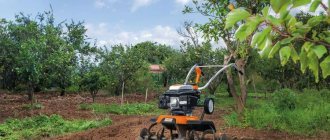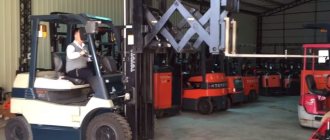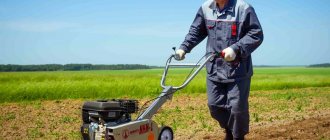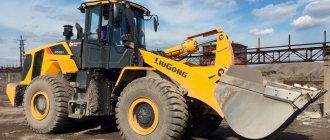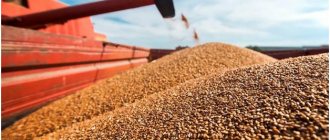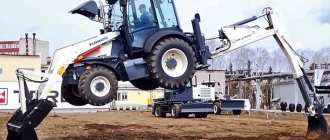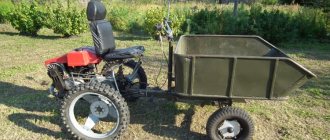Without the use of mechanized tools, it is impossible to prepare the land for planting crops and reap a bountiful harvest. This applies not only to large farms, but also to small household plots.
In the second case, motorized cultivators are popular among summer residents. However, some owners of personal plots believe that a motor-cultivator and a walk-behind tractor are different names for the same type of equipment.
We will tell you about the difference between the units, give models of popular domestic manufacturers, and explain what are the key points when choosing a motor cultivator.
The feasibility of homemade products
Despite the fact that there is a greater variety of attachments on the market, they may not always be suitable for certain tasks.
And the price-quality ratio sometimes leaves much to be desired. Therefore, many gardeners make the necessary accessories for walk-behind tractors with their own hands. To do this, it is enough to have a drill, grinder and welding machine on hand, as well as have the skills to work with them. Only in individual cases, when more precise calculations and turning work are needed, do you have to turn to highly specialized specialists.
An advantage to homemade products is that at any disassembly site you can easily find the necessary component or assembly from an old car suitable for construction.
Mini bulldozer
You can turn a walk-behind tractor into a miniature bulldozer capable of leveling small areas or removing snow and debris by installing a shovel blade on it. For this, sheet metal with a thickness of at least 3 mm is used. The lower part of the shovel should be slightly bent forward in relation to the general plane, and a strip of thick rubber should be attached to it for snow removal or sheathed with tin (for excavation work). To strengthen the entire structure at the rear, it is necessary to weld several stiffening ribs from a metal corner.
Self-propelled rake
Despite the availability of factory-made rakes, many farmers prefer to make them themselves, taking into account the characteristics of their farm: the size of the meadow, the relief.
Metal pipes and hardened rods are used as materials for rakes. But as an option, you can use factory manual forks by welding them to the base. For ease of work, it is advisable to install small wheels or ski feet at the edges, which will relieve the load on the entire structure.
Types of attachments
If you want to make your cultivator truly multifunctional, we recommend installing additional attachments on it. This equipment allows you to perform not only standard types of work such as plowing or loosening: with certain types of attachments you can hill up the soil, plant and harvest potatoes, cut furrows, and sow seeds. Some attachments are designed for tasks such as making hay, removing debris and snow. The use of attachments will save a lot of money, because you do not have to purchase separate equipment for various types of agricultural work.
Hinges can be divided into two types: active and passive. Active ones have moving parts that begin to work using the cultivator engine. The rotational energy of the engine is transferred to the linkage either with a belt drive or through a special power take-off shaft. Active type attachments include a snow blower, different types of mowers, and a sweeping brush. Passive attachments are not equipped with their own moving parts and are activated only by the movement of the cultivator itself. The most popular attachments of this type are a plow, a hiller, a potato planter, and a potato digger.
Let's look at the most useful and popular types of attachments among farmers.
Hitch
This is an auxiliary adapter element that allows you to attach any attachment to the cultivator. Without a hitch, you are unlikely to be able to install a plow or hiller.
Advice! As a rule, each specific model has its own individual coupling mechanism. It is therefore recommended that the operating parts of the hitch and the hitch be manufactured by the same manufacturer.
There are both universal hitches and hitches manufactured for a specific brand. Typically, the towbar is installed at one time using mounting brackets. Removing it is much easier; it is not necessary to use additional tools.
Hiller
An experienced farmer rarely does his work without it. The equipment facilitates hilling the soil, forms smooth ridges and an earthen ridge. Most often, the cultivator is equipped with a special hiller for potatoes. It is used for cutting even furrows and digging up root crops during the harvest period. There are hillers with dump plowshares (steel sheets) and disk hillers of the propeller type. Today, disc hillers are most in demand in agriculture; most modern manufacturers produce them. When performing its functions, this type of hiller encounters much less resistance from the ground. As a result, the load on the equipment and the lead operator is reduced. By adjusting the settings when installing the disc hiller, you can form earth ridges of different heights. At the same time, the earthen ridges are stronger and more stable than those of hillers with ploughshares. When creating a ridge, the latter pour part of the earth back into the furrow.
Disc hiller for cultivator
Plow
They are used for virgin soil during plowing, when it is necessary to turn over large layers of earth. The hitch is installed via a hitch or a special adapter. Nowadays, summer residents use one of two types of plows: standard and reversible. A conventional plow forms a moldboard in only one direction during operation. The reverse one, in turn, consists of two plows, therefore, soil dumps are carried out on two sides at once. With the help of the second type of plow, you can plow a large area of the site much faster and more efficiently.
Reversible plow
Potato planter
Purchasing this attachment will save you from the tedious and time-consuming procedure of planting potatoes. The planter is a complex unit consisting of a small plow, a hopper with a transport belt and a disc hiller. The plow forms a trench and prepares the soil for planting root crops. Seed material for planting is loaded onto the transport belt. The compact hiller loosens the soil and sprinkles the planted material.
This equipment is productive, but expensive. However, the potato planter fully justifies its price when cultivating a large number of hectares of land.
Potato digger
The main task of the hitch is to collect the finished crop. The design is similar to a hiller, but instead of steel blades it has long arms reminiscent of a broom. The principle of operation is simple: the rays dig up the surface of the soil, the soil is thoroughly sifted, and the pulled out root crops are automatically thrown in the other direction. The attachment is fastened to the cultivator via a hitch.
Grain planter
As the name suggests, this attachment is used for planting seeds. Available in two variations: 2-row planter and 4-row. The hitch is a complex consisting of a hopper for seed material, a calibration disk, and a small plow for cutting furrows. To prevent the planter from slipping, a steel lug is installed in the rear part of it.
Equipment for land cultivation
To cultivate the land, craftsmen have developed a number of devices that are superior in quality to factory products.
Most often, a do-it-yourself plow is used as a device for a walk-behind tractor, since factory prices are quite high. To make it, you should use sheet iron with a thickness of at least 4 mm, from which the knife itself and pipes with walls of the same size for the frame and fastening are cut directly.
Hiller
A device for hilling beds can be made from two metal disks.
They must be the same size with a diameter of at least 50 cm. It is advisable to pre-sharpen the edges of the disks for better soil sampling. Their fastening to the frame should be thought out so that it is possible to change the distance between the disks in accordance with the width of the bed.
You can also consider new versions of various devices that make the work of caring for a garden easier as homemade products for a walk-behind tractor :
Their drawings can be easily found on the Internet and taken as the basis for a future product.
Rating of TOP 4 best models
| Place | Name | Price |
| TOP 4 best cultivators | ||
| 1 | Daewoo Power Products DAT 4555 | 19 000 ₽ |
| 2 | Daewoo Power Products DAT 5055R | 22 000 ₽ |
| 3 | MOBILE K MKM-MINI MIL0016682 | 18 000 ₽ |
| 4 | Huter GMC-5.0 | 14 000 ₽ |
From tractor to boat
The most common modifications from a conventional walk-behind tractor are all kinds of complex equipment and vehicles.
True, the latter can be more called homemade products based on the engine and transmission of the device. Potato planters . If there is a large area for planting potatoes, a device based on a walk-behind tractor would be ideal. It includes several elements at once. First of all, the potato planter is equipped with a small hopper for tubers.
In front of it is a plow that makes a ditch, and behind it is a hiller that fills and forms a bed. All devices must be adjustable in accordance with the planting depth and size of the beds.
Mini tractor . Most often, craftsmen construct all kinds of mini-tractors. In this case, the shift in the center of gravity of the equipment should be taken into account, since the engine is installed in the rear. Therefore, care should be taken to expand the wheelbase of the rear axle.
Currently, you can find on sale all kinds of components and assemblies for creating a tractor based on a walk-behind tractor, such as front axles, brake system, all kinds of rods and levers, pedals. But if you wish, you can make all this yourself, using suitable parts from old cars.
When using more powerful tires, such a tractor can easily turn into an all-terrain vehicle.
Boat motor . The engine from a walk-behind tractor can also be an ideal replacement for a conventional outboard motor. To do this, the necessary fastening should be made on the boat hull, and the standard engine cutter should be replaced with blades. In the right hands, a walk-behind tractor can also become the basis for creating a small buggy-type car. True, it will not be possible to drive in urban conditions - this is due to the official registration of the vehicle with the state traffic inspectorate. But it can be an excellent help in rural areas for fishing trips or hunting for mushrooms. Also, such an “SUV” is ideal for mastering driving skills for beginners.
Division by class
Cultivators are conventionally divided into three classes:
- Heavy versions (more than 60 kg), capable of cultivating up to 30-50 acres of any land.
- Medium-heavy equipment (from 30 kg), which can also cope with untreated areas of 10 to 30 acres; are considered the best cultivators for the garden and are in greatest demand.
- Lightweight options can easily cope with an area of 3-5 acres, are convenient for loosening beds, lawns, flower beds, as well as greenhouses, even for women or elderly people, and are as compact as possible.
Each model has its own advantages and range of operating conditions.
How to make a walk-behind tractor from a cultivator
Cultivators and walk-behind tractors belong to agricultural machinery and act as indispensable assistants for the population of the private sector, as they are multifunctional and practical. Many people believe that a cultivator and a walk-behind tractor perform the same function and do not see a significant difference between them. The cultivator is intended only for soil processing, while the walk-behind tractor has wide functionality and is aimed at performing various works on a summer cottage. However, the heaviness of walk-behind tractors leads to rapid fatigue of people who use them to work on their plots. In this article we will tell you how to make a walk-behind tractor from a cultivator in order to greatly facilitate the work of land lovers.
Electrical unit - to the dacha!
Electric cultivators can serve as an excellent addition to a set of various garden equipment. They have a wide range of undeniable qualities and advantages.
Thus, during the production activity of an electric cultivator, there is no combustion of gasoline and, accordingly, there is no exhaust gas emission. And this is very important when working in closed areas, in greenhouses.
It is easy to maintain: you only need a little maintenance of the cutters, lubricating the parts and changing the oil. Since the electric cultivator operates from the mains, you do not need to constantly monitor the fuel level in the engine - it will not stall due to lack of fuel.
We recommend reading:
The best garden shredders: TOP 3 best models and brands of 2022 (95 photos and videos)Which chainsaw is better? Tips for choosing the best models of professional and household chainsaws (115 photos and videos)
- Garden tools - the best tools, equipment and options for their use (110 photos)
In financial terms, the operation of electrical units is acceptable and economical. And from an ergonomic standpoint, the device is convenient for summer residents and easy to operate. You just need to press the “start” button and the process will start.
Meanwhile, among the disadvantages of electrical engineering, one can note the relatively low power and the need to use electrical networks, which limit the space being processed and simply “dangle” underfoot.
The technical characteristics of electric cultivators include, first of all, the mass of the unit, its power, the number of cutters, the depth and width of processing.
For example, in terms of weight they are ultra-light (up to 15 kilograms; width and depth of processing with a cultivator 30 and 10 centimeters), light (35-40 kilograms; 40-50 and 10-15 centimeters), medium (65-70 kilograms; 20 centimeters ) and heavy (100 kilograms), which are used especially on large farm plots.
Why do you need to modernize your cultivator?
The cost of a cultivator is several times lower than that of a walk-behind tractor, so many people prefer the first option. However, when performing various tasks with the ground, they are faced with the problem of low functionality of the cultivator, which is not oriented towards shallow digging of the soil or harvesting. Having design skills, you can solve this problem by converting the cultivator into a walk-behind tractor, while saving the family budget.
If you use attachments such as hillers, plows, and the like, then a reduction gear is extremely necessary. Because you need increased torque at low speeds. To do this, it is necessary to accelerate the engine to higher speeds, since the cultivator is designed to work with only one cutter and in order to provide the opportunity to install diverse attachments on it, it is necessary to make a walk-behind tractor from it. To get a low gear on the cultivator, it is advisable to install a special gearbox on it. Initially it seems that this is a complex technical device that can only be made in a factory using special equipment.
However, in fact, remaking a transmission mechanism that converts angular velocity into one or more mechanical gears with your own hands is not a difficult task.
First you need to establish yourself with the basic operational parameters of the power plant. The technical documentation indicates the number of revolutions of the crankshaft. This is the main value that is necessary for making calculations when converting a cultivator into a walk-behind tractor. To create a reduction gearbox for a cultivator you will need the following tools and materials:
- Bulgarian;
- welding machine;
- drill;
- sandpaper and drills;
- ruler;
- vice;
- hammer;
- metal sheet approximately 5 mm thick;
- pipe for fixing bearings.
Additional tips and tricks
I would also like to say a few words about attachments for cultivators. They come in different types and functions. However, you should know that if your cultivator is not large, then, accordingly, there will not be much variability in attachments. Nozzles are included.
Below are some operating tips:
- Before you buy the cultivator of your dreams, study all the intricacies and details of the model you want to purchase.
- If it's time to change the oil on your cultivator, choose it relative to the engine stroke, otherwise you have the opportunity to ruin it.
- If your cultivator comes with poor quality accessories, we caution you to avoid that model altogether.
- If you have a gasoline cultivator in your arsenal and you haven’t used it for a long time, first you should warm up the machine and then use it for its intended purpose.
- Before you start working with the cultivator, walk through the area where you are going to cultivate the land and remove (if any) large objects or debris, since if excess gets into the mechanism, the cultivator will throw it all away with considerable speed.
- It is advisable to check the oil level of the machine before each operation.
- Always wear clothing that will cover your body, as it may happen that the unit may tip over if used incorrectly.
Storing the cultivator will not be difficult for you . After work, you should remove the gasoline and soil that is stuck there. Next, simply wipe the cultivator with a rag and, in order to prevent the cultivator from rusting, simply rub it with oil. This unit must be located in a dry place.
Gearbox installation
The basic element of the stroke reducer being created for a cultivator is the body. The quality of the entire mechanism, the mutual arrangement of the axes and shafts, and the single center of rotation of the bearings directly depend on it. In our case, the body will be made of metal sheet by welding. To simplify the procedure for servicing the component parts of the gearbox, one of the walls must be made removable. The bearings and their precise boring are supported by pieces of pipe whose inner diameter coincides with the outer diameter of the bearing. After the trimmings are fixed in the desired position, they are thoroughly secured by welding.
For the manufacture of shafts, a rod with a round cross-section made of high-quality steel is used. The workpiece is machined to the required parameters and the shaft is given the desired shape. During operation, the shafts rotate together with the sprockets, transmitting torque through the chain and keys. The shafts are supported by bearings, which take on significant loads during excavation work. The service life and performance of the created gearbox will largely depend on how correctly the bearings were selected. The best option would be to use closed radial bearings, which require little maintenance. Sprockets and chain can be purchased or used from decommissioned equipment.
The sequence of assembling a reduction gearbox for a motor cultivator:
- Cutting a metal sheet into component parts of the body and cover.
- Pipe cutting.
- Installation of bearing seats.
- Manufacturing of the body.
- Coating the body and lid with paint and varnish.
- Mounting bearings.
- Mechanical processing of shafts.
- Installation of shafts with simultaneous installation of sprockets and chain.
- Securing the housing cover.
After the manipulations have been performed, the converted mechanism is installed on the cultivator frame and sea trials of the cultivator are carried out. The use of a homemade gearbox increases the power of the equipment and makes it possible to expand its scope.
Electrical engine
Equipment with an electric or gasoline engine is available for sale. Which cultivator is better? To make the right choice, you need to know the features of such technology.
Electric motors began to be installed on cultivators at the beginning of the last century. Modern models of such equipment differ from the equipment of the last century in lightness, greater safety and maneuverability. The dimensions of cultivators with an electric motor are relatively small.
During operation, this type of equipment does not emit harmful, toxic substances into the environment. Therefore, when considering which cultivator is best for a secluded, quiet country house in nature, you should definitely choose an electric motor. The owners of such a site go out into nature to relax, breathe fresh air, and not the exhaust of a noisy gasoline engine.
However, it should be remembered that cultivators with an electric motor also have certain disadvantages. The device will be followed everywhere by a cord that needs to be powered into the network. This limits the scope of application of the technology. While working, you need to constantly monitor where the network cable is located. Otherwise, it may be damaged and serious injury may occur. It is also worth noting that the power of such equipment is low. It does not exceed 3 kW (4 hp).
What is needed and how can it be changed
In fact, putting a motor cultivator on wheels is not at all difficult:
- First, you need to carefully measure the fit dimensions of the output shaft, paying special attention to its shape (cylinder or hexagon), outer diameter and distance to the hole for the cotter pin.
- Then you need to visit the nearest gardening store or look online to order hubs (differential amplifiers) that match the dimensions of the cultivator shaft.
- At the same time, you can purchase wheels (the smaller the diameter, the better) for your future walk-behind tractor. By the way, wheels with hubs and drawbar are often sold in a single set, which is very convenient.
- We screw the purchased wheels to the hubs;
- We remove the cutters from the motor-cultivator shaft;
- We install the wheels on the gearbox shaft.
Experts do not recommend upgrading low-power cultivators weighing up to 45 kilograms and equipped with a worm gear in this way, as this modification can lead to serious damage. In addition, when converting a motor-cultivator into a walk-behind tractor, you should not use old car wheels (too much weight and size).
At the same time, it is worth understanding that a cultivator on wheels, the modification of which will require at least three thousand rubles, may be a walk-behind tractor, but not quite a full-fledged one. Of course, such equipment will be able to move independently, but serious problems can arise with the use of attachments if the cultivator’s motor is weak (less than 6 hp) and the reduction gear is of a worm type, rather than a gear, belt or chain type.
Therefore, the next stage of converting the cultivator into a walk-behind tractor should be replacing (if necessary) the gearbox. The cost of this part in stores is comparable to the price of a new cultivator. However, you can try to make a simple gearbox with two opposite shafts at home, if the owner of the cultivator has the skills of a good mechanic/designer and has:
- measuring instruments (ruler, caliper);
- spare parts and consumables (bearings, gears, belts or chains, pulleys, shafts, gaskets, seals, pipe for bearings, bolts, etc.);
- welding machine;
- drill and drill bits of different diameters;
- “grinder” or hacksaw for metal;
- set of screwdrivers and vice.
If all this is available, then you can start manufacturing the gearbox:
- We draw or search on the Internet for a suitable sketch and calculate the gear ratio, taking as a basis the number of engine idle speeds plus 10%.
- We cut a metal sheet with a thickness of at least 5 mm to obtain a blank for the lid and body of the future part.
- We cut the pipe and, using welding, install the seats for the bearings.
- We assemble the body and protect it with paint and varnish.
- We install bearings.
- We produce and process shafts from round steel bars.
- We install shafts with the simultaneous installation of sprockets or pulleys, chains or belts.
- We make a gasket between the body and the cover, and also insulate the shafts using seals.
- Fill the housing with lubricant (oil) and install the cover.
- We place the homemade gearbox on the cultivator frame and connect it to the engine via the output shaft.
- We adjust the operation of the gearbox with the engine turned on, but without any special loads, so that the parts can be worn in.
Famous manufacturers
There is a large selection of such equipment on sale. It is produced by different manufacturers. Cultivators from Champion, Texas, MTD, Husqvarna, Caiman, Viking, etc. are in demand. The leading places in the ranking of manufacturers are occupied by companies from the USA and Europe. However, domestically produced products are also in demand in our country. The most popular is the Russian brand Elitech. This manufacturer's line includes many light, medium and heavy models. The cost of domestically produced products is reasonable and the quality is high. This makes the presented company popular and in demand.
If you want to save money on your family budget, but at the same time purchase foreign-made equipment, you should pay attention to Champion cultivators. They are produced by the USA together with China. Texas is also known for its reasonable price and decent quality. Its products are produced by Denmark jointly with China.
When choosing a cultivator manufacturer, you should give preference to well-known, proven brands. They are constantly improving their products. The quality of the equipment in this case will be much higher.
Having considered what a cultivator is, its features and varieties, every owner of a summer house or personal plot will be able to choose the best option for himself.
DIY hand cultivator
With the onset of spring, summer residents and owners of garden plots have a lot of work, because before planting garden crops, soil cultivation is required. The most difficult work is considered to be digging and loosening the site . For this purpose, most summer residents use an ordinary shovel, but such work takes a lot of time and effort. Fortunately, there is a more effective device - a cultivator. With its help, you can complete a large amount of work in a short period of time. You can buy a device or make a manual cultivator with your own hands, saving a lot of money.
DIY hand cultivator
Other transmission elements
The hitch for a cultivator can also be of different types. It is necessary to install it in such technology. There are belt clutches, with a release clutch, and automatic clutches. They determine certain qualities of the equipment.
Clutches with a release clutch can be found mainly on professional models of motor cultivators. It ensures long-term operation of the system under high loads. If the unit is equipped with a belt coupling device with a tension roller, this unit is of average cost. Budget models are equipped with an automatic centrifugal clutch.
When choosing equipment, it is important to pay attention to whether the system has reverse gear. This is a useful feature that greatly simplifies the soil cultivation process. In most light motor cultivators there is no reverse gear. In other types of equipment this function should be present.
The number of gears is also important. There must be at least two of them. If there are more gears, the equipment will be more versatile. It will be convenient to use during soil cultivation.
More about the device
The most popular are small designs whose weight does not exceed 20 kg. They are very productive and compact, and with the help of such products you can perform various tasks on the site: removing weeds, loosening the soil and even applying various fertilizers. A hand cultivator will also be useful when caring for some plants, as it is capable of loosening the soil near the beds, thinning and hilling them.
Small hand cultivators are popular
Note! Of course, you cannot compare a hand-held cultivator in terms of power with a walk-behind tractor, but for basic tasks in a garden plot it is quite enough. The advantages of hand tools include the absence of fuel or electricity costs, as well as the ability to use them in hard-to-reach places.
Such a cultivator cannot be compared in power to a walk-behind tractor.
The design of most types of cultivators includes special cutters, which, moving around the site, loosen the soil. Other attachments can also be used:
- paws for loosening the soil;
- a special sock that loosens and cuts the soil, thereby removing weeds;
- hiller for creating small grooves in the soil, which are needed for sowing various crops;
- needle disk , which is used when a large crust forms on the soil surface;
- feeding knives with special dispensers . They are necessary for applying fertilizers to the soil.
Gas engine
Garden cultivators can run on a gasoline engine. They are highly popular. Equipment of this type is powerful and productive. However, the cost of a cultivator with an internal combustion engine is higher.
Also, the presented equipment is more difficult to maintain. It is necessary to periodically clean the engine, use special oils and perform other operations. Such equipment cannot be used in enclosed spaces (for example, in a greenhouse) due to exhaust gases.
Types of cultivators
The classification of devices is carried out depending on the mechanisms used. Cultivators are shared with the following equipment.
- Electrical . Mainly used for processing large areas. The device can only operate if there is a source of electricity. The design is lightweight and compact in size; moreover, such devices do not pollute the atmosphere with harmful substances.
Electric cultivator DAEWOO
- Rechargeable . This type of equipment is used to work in small areas. The advantages of battery-powered cultivators include high mobility and small dimensions.
- Gasoline. Another type of equipment that is considered one of the most common among summer residents. It has high performance, good mobility, and is easy to use. But such devices must be properly maintained, not to mention polluting the atmosphere with harmful substances. Hyundai petrol cultivator Mechanical. It is no secret that hand cultivators are very easy to use, they do not take much time and effort, and are also low in cost. There are several types of designs of hand cultivators, starting with a simple “Tornado” cultivator, which is an ordinary fork with curved fingers on the bottom, and ending with a flat cutter. Hand cultivator
The advantages of hand cultivators also include the fact that they are easy to make yourself. This does not require special skills, just follow the recommendations. To make a particular design, you need the correct drawing of the product, a little free time, patience and, of course, some tools and materials.Hand cultivator "Gnome"
DIY flower pots
In our new article, we share the best flower pot ideas! The most original and beautiful options, step-by-step manufacturing instructions, useful tips - all this can be found in this article!
Parameters of motor cultivators
To buy a good self-propelled vehicle, you must first understand what it is, what characteristics the equipment has, and understand which device is most suitable for you.
Classification
Let's look at what types of units there are by engine type and power supply.
Gasoline
They work with an internal combustion engine and have different power levels. They are very popular due to their autonomy: to start, you just need to fill up with gasoline. This gives freedom of movement and allows you to use the device both in the garden and in the field.
This category of devices has good performance indicators and is suitable even for virgin soil. The advantages also include the high reliability of the mechanism.
Such instruments are not without their imperfections: heavy weight, loud sound and harmful exhausts, which limit their use in enclosed spaces, such as greenhouses.
Electrical
They do not have all the above-mentioned disadvantages of gasoline samples, since such equipment receives energy from electricity. Accordingly, a fuel tank is not required, which means the weight and dimensions of the tool are reduced.
Another problem arises: to start it requires a connection to the mains, and such equipment cannot be turned on far from the outlet. There is also always the danger of being distracted and accidentally tangling or cutting the wire.
Thanks to its compact size, even women can operate the device. However, this type of machine is unable to cope with clay soils.
Rechargeable
As the name implies, this group of devices operates on battery power. These devices do not have any emissions, there is no unnecessary noise, and the weight is significantly less than that of gasoline ones. They can be used at any distance from home, as long as the battery is charged.
But this is their main weakness: as soon as the battery runs out, you will have to stop plowing and wait several hours until the charge is replenished. The battery usually doesn’t last long, so it’s unlikely that you’ll be able to cultivate extensive areas with this assistant.
Weight and power
The power of the cultivator is measured in horsepower (for gasoline models) or kW (for electric ones). The classification of all units, depending on these parameters, looks like this:
- Ultralight - weight from 7 to 15 kg, and power indicators are in the range of 1–2 liters. With. or 0.6–1.5 kW. They are good for improving greenhouses, small beds and flower beds, since they plow the soil shallowly.
- Lightweight - weigh up to 40 kg and power 2.5–4 liters. With. or 2–3 kW. They cope with an area of up to 10 acres.
- Medium - larger: 40–60 kg, with indicators of 4.5–6 liters. With. or 3–4.5 kW. They also cope with difficult breeds.
- Heavy - increased characteristics: weight more than 60 kg and power from 6 liters. With. or 5 kW, make them a universal option that can be used to plow virgin soil and a huge field. In addition, the range of functions expands and it becomes possible to connect additional equipment.
You should select a device based on the size of your plot and the type of soil. You should not buy a heavy unit for a small gardener, since it is impossible to realize its capabilities there, and the money will be thrown away. But it is also undesirable to save money if you have wide areas of land: low-power models simply will not cope with the task and will fail.
Plowing quality
This includes the width and depth of plowing. The wider the grip, the sooner the garden will be processed, but at the same time, the compact blades allow you to cultivate the soil in narrow places.
- Small products can take up no more than 50 cm of space, while going deeper by 7–15 cm. This is enough for flower beds and crops with a shallow root system (onions, strawberries, tomatoes).
- Medium machines process 50–80 cm in width and 23–28 cm in depth, which is optimal for planting potatoes.
- Reinforced options for virgin soil with a grip of up to 1 meter can loosen the soil by 30–35 cm.
Number of speeds
Simple models have only one average forward speed. In principle, this will be quite enough for a well-kept garden. Although a problem often arises in the process: when the equipment reaches the edge of the site, you have to strain to pull the cutters out of the ground and turn the equipment around. This is only available to physically fit people.
To avoid any difficulties, it is worth purchasing a unit with reverse – a rear speed at which the cutters rotate in the opposite direction. When you turn it on, you can easily pull the blades out of the soil and turn around.
Having two or three forward movement modes is advisable if you plan to process difficult areas. So, for virgin lands you will need rotation at low speeds. At high speeds, you can quickly crush already prepared soil so that you don’t have to work with a rake or hoe.
Additional features
As has already been mentioned several times, a cultivator can not only plow, but also carry out many other operations. This is possible thanks to the availability of additional replaceable equipment:
- reinforced cutters for difficult places;
- V-shaped hiller for digging holes and loosening around plants;
- single- or double-sided plows of various designs;
- potato digger;
- harrow;
- buckets for removing snow and fallen leaves;
- mowing machine;
- cart;
- plow.
When using additional equipment, especially those that make the structure heavier, you need to be more careful not to overload the engine. To do this, strictly follow the manufacturer’s instructions and do not try to “force” the device to do something that it cannot do.
Pens
The device is controlled using handles on which the gear shift and clutch are located. It is necessary to ensure that these handles are pressed smoothly and without unnecessary effort.
The cables leading to the handle must be well protected from dust and dirt, otherwise they will break and the functioning of the equipment will be impaired.
It will be useful to have a “Stop” button on the handle. It will provide emergency braking in unexpected situations.
The handles themselves, by which you need to hold the device, should be comfortable, preferably with rubberized inserts so that your hands do not slip.
Manufacturers
Among the manufacturers of motor cultivators, the following well-known companies stand out:
- Daewoo, Hyundai – Korea;
- Huter, Al-ko – Germany;
- Honda - Japan;
- Viking – Austria;
- Husqvarna - Sweden;
- Greenworks - America;
- Champion, Elitech, “Neva”, ProRab – Russia.
Many brands have production facilities located in China, but this is not something to be afraid of. Good companies use only high-quality materials and strictly monitor compliance with technology.
Be sure to pay attention to the warranty period that the manufacturer gives for your product - it must be at least 24 months.
What do you need for work?
To make various devices for soil treatment at home, you need to prepare special materials for this. First of all, you need to take care of getting steel. The more different pipes, sheets or metal rods you have, the better. You can’t do without a set of tools, but they are present in any garage, so you don’t have to bother finding them.
When working with metal pipes, you cannot do without special tools.
A welding machine is one of the most important tools for working with metal products. With it, you can connect different parts made of metal in just a few seconds. Of course, in most cases you can do without a welding machine by connecting the parts using self-tapping screws. But the quality of such connections cannot be compared with the quality of welds.
Inverter welding machine
Assembly of hand cultivators
Once you have prepared everything you need for work, you can begin making a hand cultivator. This is a unique product that has a number of advantages, for example, compactness, availability of materials for its manufacture and the efficiency of the finished cultivator.
Manual soil cultivator
A homemade cultivator will make it possible not only to remove weeds throughout the entire area, but also to thoroughly loosen the soil. But, as noted earlier, hand cultivators are not intended for large areas , so if your garden or vegetable garden has a large area, then it makes sense to purchase a gasoline cultivator. Manual structures are best suited for country work. At home, you can make such types of hand cultivators as rotary, disk, flat cutter and others.
Cultivator-weeder: 1 — wheel assembly (from a garden cart), 2 — main frame, 3 — spring, 4 — chain lock, 5 — hook, 6 — U-shaped rotary handle assembly, 7 — Ml2 fixing screw with hexagon head (3 pcs.), 8 — rotating bracket, 9 — weeder frame (steel strip 20×7), 10 — mounted raker (steel chain from a rod with a diameter of 10), 11 — 15-star weeder-clump breaker (from agricultural machinery), 12 — M10 nut with lock nut and washer (2 pcs.), 13 — rotating cultivator arm (from agricultural machinery, modified), 14 — axle bolt with nut and washers (2 pcs.), 15 — M14 bolt with nut (2 pcs.) .).
Rotary cultivator
The main tasks of the rotary structure are to harrow the soil and further level it. The cultivator consists of special hemispherical disks in the amount of 2 or 4 pieces. Each pair of these disks is attached to an axis, due to which the base of the structure can move. This allows you to increase or decrease the angle of inclination of the disks during operation.
Diagram of a rotary disk cultivator
The base must be metal, since it is subject to a large load during operation. The base itself can be attached to the handle. If all the parts are made of metal, this will significantly increase the weight of the structure, which is why many summer residents make handles from wood. When working, grass will not cling to the discs of such a cultivator, which is very convenient, especially when cultivating areas covered with weeds.
Lightweight DIY cultivator Disc rotary cultivator
Cultivator "Tornado"
An excellent cultivator with the simplest design, consisting of only three parts - a submersible element, a handle and a handle . In many ways, the principle of operation of a cultivator is similar to the operation of a corkscrew. You need to press the structure into the ground and rotate it, and then the cultivator can be lifted. During the treatment of the site, weeds are removed along with the root system. The product can easily be made at home if you follow the step-by-step instructions below.
"Tornado" - manual cultivator
Table. Manufacturing of the Tornado cultivator.
Two-stroke or four-stroke engine?
The motor can be two- or four-stroke. They differ in a number of characteristics. If you want to purchase a productive and inexpensive cultivator, you should give preference to models with a two-stroke engine. They are 65-70% more powerful than equipment with a four-stroke engine.
But two-stroke engines also have a significant drawback. They consume more gasoline. At the same time, the resource and endurance of such units is lower than that of four-stroke internal combustion engines. For this type of engine, you need to purchase high-quality oil and fuel. Moreover, they must be mixed in proportions clearly established by the manufacturer. Repairs are more expensive, while breakdowns occur more often than with cultivators with a four-stroke engine.
Almost all new models of the presented equipment are equipped with four-stroke engines. This significantly increases comfort during tillage. Four-stroke engines are less noisy and heavier. This makes the process of loosening and plowing easier. Four-stroke internal combustion engines have fewer harmful emissions. This is a reliable, durable technology.

